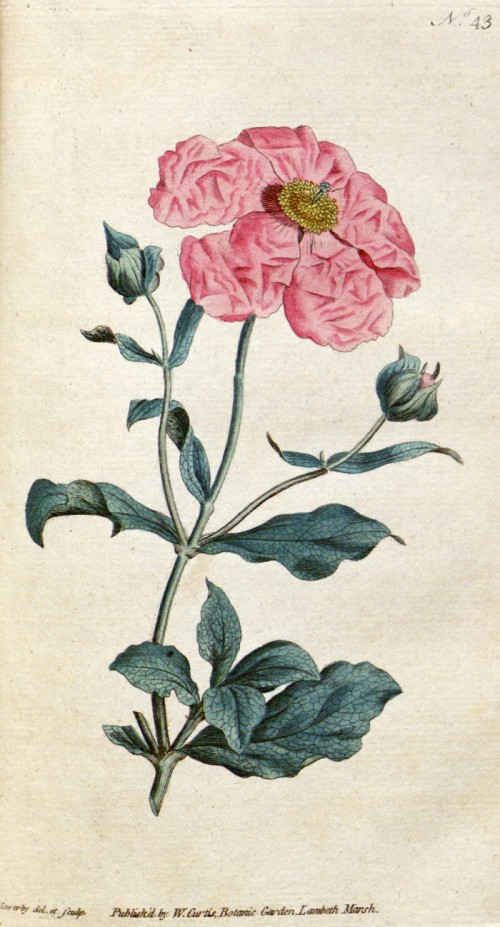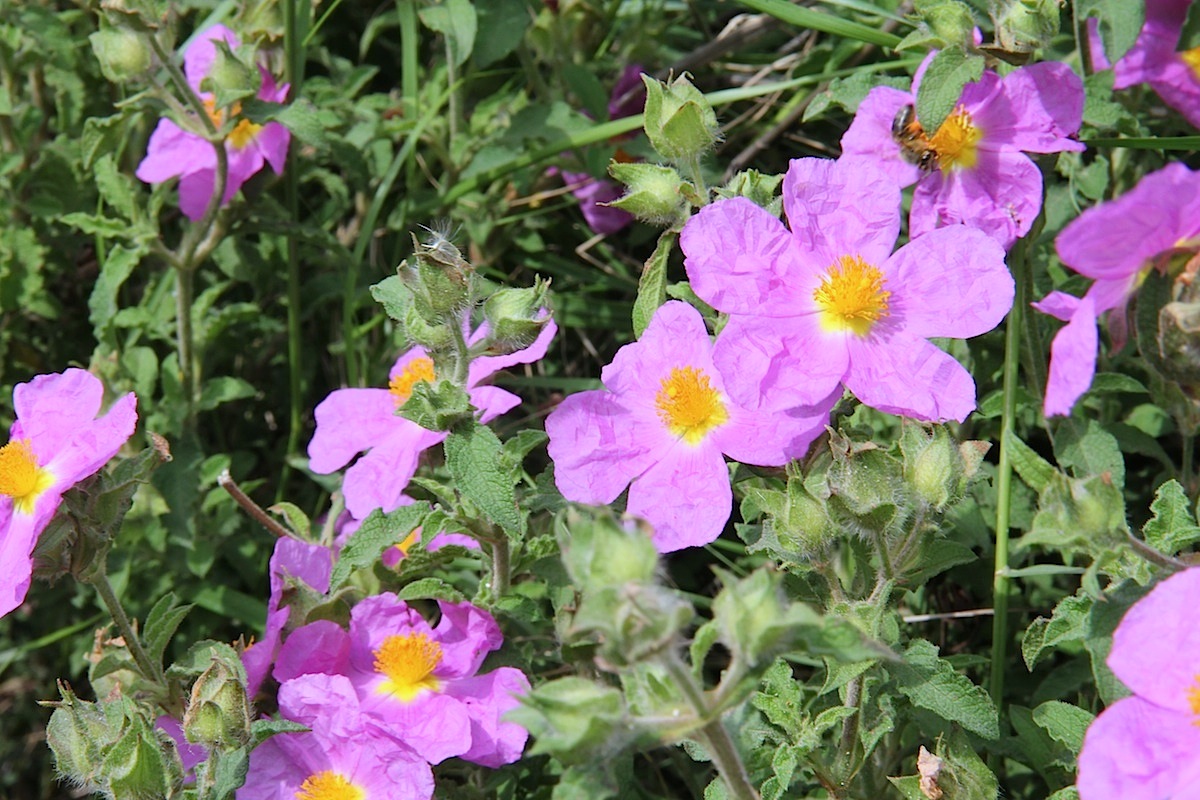Cistus creticus L. - syn.Cistus incanus auct. - Cistaceae - pink rockrose, hairy rockrose, Kretische Zistrose, Graubehaarte Zistrose
Evergreen aromatic shrub, up to 1.5m tall, native to the Mediterranean; leaves ovate to elliptic, with glandular hairs, margins undulate; petals deep rose with yellow base.
Subordinate taxa: Cistus creticus subsp. corsicus, Cistus creticus subsp. creticus, Cistus creticus subsp. eriocephalus
http://www.ars-grin.gov/cgi-bin/npgs/html/taxon.pl?405608
„This shrub with hairy branches reaches heights of 30 to 100 cm. The stalked leaves are 3-15 mm long and have a wavy depending on the subspecies (subsp. creticus) or smooth edges.“ The hot water extract of the dried leaves is used to treat diseases of the skin and mucous membrane disorders like diarrhea in Greece. http://de.wikipedia.org/wiki/Cistus_incanus
„Four monomeric and seven oligomeric flavanoids have been identified from a Cistus incanus subspecies traditionally used for treatment of skin diseases in northern parts of Greece and identified as subsp. tauricus. Flavan-3-ols are (+)-catechin, (+)-gallocatechin, the novel (+)-gallocatechin 3-gallate and the rarely occurring (+)-catechin 3-O-α-β-rhamnoside; proanthocyanidins are procyanidins B1 and B3, gallocatechin-(4α → 8)-gallocatechin, its novel (4α → 6)-regioisomer, gallocatechin-(4α → 8)-catechin, the tentatively identified novel catechin-(4α → 8)-gallocatechin and the trimer gallocatechin-(4α → 8)-gallocatechin-(4α → 8)-catechin. The uncommon flavanone 2R,3R-dihydromyricetin was also obtained.“
[Flavan-3-ols and proanthocyanidins from Cistus incanus. Frank Petereit, Herbert Kolodziej, Adolf Nahrstedt, Phytochemistry, Vol.30 (3), 1991, 981–985]
Several labdane-type diterpenoids with antibacterial properties were isolated from the leaves of Cistus incanus subsp. creticus.
[Cytotoxic and Antibacterial Labdane-Type Diterpenes from the Aerial Parts of Cistus incanus subsp. creticus, I. Chinou, C. Demetzos, C. Harvala, C. Roussakis, J. F. Verbis, Planta Med, Vol.60(1), 1994, 34-36]
Major components of the essential oil from Cistus creticus leaves, which exhibited a strong antibacterial activity against Gram + bacteria, were manoyl oxide (19.6%) and 13-epi-manoyl oxide (13.4%).
[Composition and Antimicrobial Activity of the Essential oil of Cistus creticus L., Demetzos, C., Loukis, A., Spiliotis, V., Zoakis, N., Stratigakis, N., Katerinopoulos, H.E., Journal of essential oil research, 7(4), 1995, 407-410]
The main components of the essential oil of the leaves of Cistus creticus subsp. eriocephalus (Viv.) Greuter & Burdet, were α-cadinene (6.5%), δ-cadinene (5.6%), viridiflorol (5.4%), bulnesol (6.3%), ledol (3.8%), α-copaene (3.8%), β-selinene (3.4%), cubenene (3.3%), manoyl oxide (9.9%) and 13-epi-manoyl oxide (3.4%).
[Composition and antimicrobial activity of the essential oil of Cistus creticus subsp. eriocephalus., Demetzos, C., Katerinopoulos, H., Kouvarakis, A., Stratigakis, N., Loukis, A., Ekonomakis, C., Tsaknis, J., Planta medica, 63(5), 1997, 477-479]
The benefits C.incanus extract for the treatment of influenza virus was under heavy discussion.
http://www.deutsche-apotheker-zeitung.de/pharmazie/news/2009/07/08/umstrittene-studien-zu-cystus052.html (german)

Cistus incanus, Botanical Magazine, vol.2 t.43 (1788) [J.Sowerby]
http://plantgenera.org/species.php?id_species=248942

Cistus creticus CC BY-SA 3.0, Author: Peter A. Mansfeld
https://commons.wikimedia.org/wiki/Category:Cistus_creticus?uselang=de#/media/File:Cistus_creticus_pm02.jpg